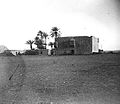Wadi al-Qura
Appearance
Wadi al-Qura (
Arabic: وادي القرى, lit. 'Valley of Villages') is a wadi north of Medina in Saudi Arabia,[1] mentioned in early Islamic sources. It was located on the main trade road between the Hejaz and Syria
. This valley is also called Imam-e-Mubeen (open way) Quran (al-Hijar).
The wadi is tentatively identified with the modern
Ibn al-Kalbi described it as highly fertile and dotted with villages throughout.[2]
The wadi is referenced in many early Islamic texts. Several military expeditions took place there during the time of the Islamic Prophet Muhammad. These include:
- the Zayd ibn Haritha to survey the area and to monitor the movements of the enemies of Muhammad,[3]
- the Second Expedition of Wadi al-Qura which Muhammad ordered to raid the inhabitants of Wadi al-Qura for revenge, because a number of Muslims were killed when they tried to raid the inhabitants previously, but failed.[4]
- During the end of Muhammad's era the Third Expedition of Wadi al Qura was ordered, with the purpose of attacking the Jews of Wadi al-Qura to conquer their land[5]
Recent discoveries of
Hai Gaon.[6]
See also
References
- ^ Wensinck, AJ, "Kaynuka, banu", Encyclopaedia of Islam.
- ^ Power, Timothy (2012). The Red Sea from Byzantium to the Caliphate: AD 500–1000. I.B.Tauris. p. 115.
- ^ Mubarakpuri, The Sealed Nectar, p. 206. (online)
- ^ Mubarakpuri, The Sealed Nectar, p. 211. (online)
- ^ William Muir, The Life of Mahomet (2003), p. 394.
- ISBN 9789004266094. Retrieved 2016-06-22.

